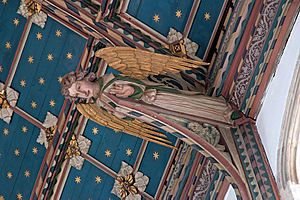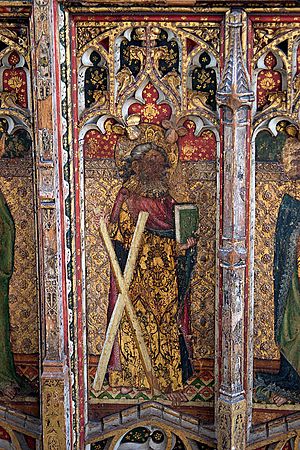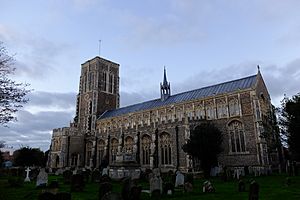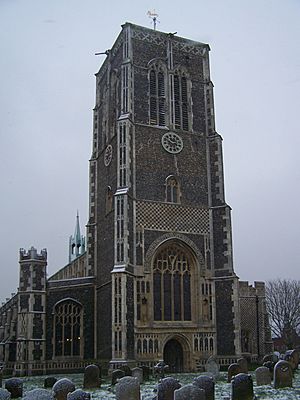St Edmund's Church, Southwold facts for kids
Quick facts for kids St Edmund's Church, Southwold |
|
|---|---|
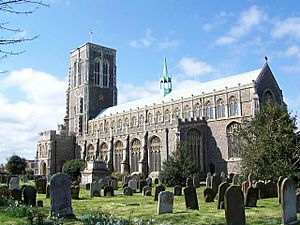
St Edmund's Church, Southwold, with pre-2015 copper roof and flèche
|
|
| 52°19′41.7″N 1°40′43.1″E / 52.328250°N 1.678639°E | |
| OS grid reference | TM 50750 76388 |
| Location | Southwold |
| Country | England |
| Denomination | Church of England |
| History | |
| Dedication | St Edmund |
| Architecture | |
| Heritage designation | Grade I listed |
| Specifications | |
| Length | 144 feet (44 m) |
| Width | 56 feet (17 m) |
| Height | 96 feet (29 m) |
| Administration | |
| Parish | Southwold |
| Deanery | Waveney and Blyth |
| Archdeaconry | Suffolk |
| Diocese | Diocese of St Edmundsbury and Ipswich |
St Edmund's Church in Southwold, Suffolk, is a very old and important church. It is a Grade I listed building, which means it's protected because of its special history and beauty. It belongs to the Church of England.
Contents
A Church with a Long History
St Edmund's Church is named after Saint Edmund. Many people think it's one of the most beautiful churches in Suffolk. It has one long roof and was built between the 1430s and 1490s. This new church replaced a smaller one from the 1200s that was destroyed by fire.
Back then, Southwold was a small fishing village. But by the 1400s, it had grown into an important town. So, the church was rebuilt to show how important and wealthy the town had become.
Amazing Stone Work and Roof
The church is famous for its special stone work called flushwork. This is where smooth and rough flints are arranged in cool patterns. Over the west window, you can see the words SCT. EDMUND ORA P. NOBIS. This means "St Edmund pray for us." Each letter has a crown and is set in the flint stones.
The church roof was originally made of lead. From 1948 to 2015, it had a copper roof with a unique spirelet, called a flèche. This flèche was just for looks and never held a bell. The tower is very tall, about 96 feet (29 meters) high.
Windows and War Damage
All the old stained glass windows from the Middle Ages were destroyed in 1644. The only stained glass you see today are the east windows above the altar, added in 1954.
During World War II, a German bomb nearly hit the church. It destroyed nearby houses and blew out most of the church's windows. This is another reason why there isn't much stained glass left. The church was quickly cleaned up for the funerals of those who died in the bombing.
Inside the Church
Inside, the rood screen is thought to be the best in the county. It stretches all the way across the church. It has three parts: one main screen and two side screens.
You can also see a 15th-century clock jack at the west end. This is a figure that strikes the time with an axe and a bell. He has a twin at Blythburgh. The Southwold jack is even a symbol for the Adnams brewery! The font, where baptisms happen, is also very impressive, even though it has been damaged over time. The painted roof in the chancel makes the church feel very open and grand.
In the north chancel, there is a special engraved window from 1971. It was made by artist John Hutton and shows St Edmund at the moment he died.
Today, the church community is very active. They use St Edmund's Hall, which was rebuilt after being destroyed in World War II, for many different events.
Restoring the Church
The church roofs were repaired in 1857 and again in 1866-1867. The chancel area was also restored in 1885.
After the lead roof was damaged by a bomb in World War II, it was replaced with copper in 1948. Over time, the copper roof wore out, especially because the church is by the sea. So, in 2013, it was decided to replace the entire roof, including the flèche, with lead again. This work started in early 2015 and was finished later that year.
The flagpole on top of the tower used to have a golden weathervane shaped like a fishing boat. The pole has since been replaced, and the weathervane was removed.
The Church Bells
Southwold tower has eight bells that are used for change ringing. In 1553, there were five bells. Over the years, some bells were recast (melted down and reshaped), and new ones were added to make the current eight.
The fourth and fifth bells today were likely recast in 1668. The third bell is from 1820. In 1828, one bell was recast, and two more were added. The largest bell, called the tenor, weighs about 546 kilograms (10¾ hundredweight). The smallest bell, called the treble, is about half that weight.
The bells hang in a wooden frame that was put in place in 1897. In 1990, the bells were rehung with new fittings, and the frame was made stronger. There is plenty of space around the frame, making it easy to reach the bells for care. The church clock uses the seventh bell to strike the hours.
The bells are rung from a special room 52 steps up the tower. This room has many reminders of past bell-ringing achievements. The tower is part of the Suffolk Guild of Ringers. The bells are rung regularly for Sunday services, weddings, and other special events.
The Church Organ
The church has a large pipe organ with three keyboards. It was first built in 1887 by J. W. Walker & Sons Ltd. Later, in 1966, it was rebuilt by a company from Thaxted. The design for the organ was created by Sir Frederick Ouseley, a Professor of Music at Oxford University.
Churches in the Area
St Edmund's Church is part of the Sole Bay Team of Churches. This team includes:
- Holy Trinity Church, Blythburgh
- St Margaret of Antioch's Church, Reydon
- St Andrew's Church, Sotherton
- St Lawrence's Church, South Cove
- St Mary's Church, Uggeshall
- St Andrew's Church, Walberswick
- St Peter & St Paul's Church, Wangford


